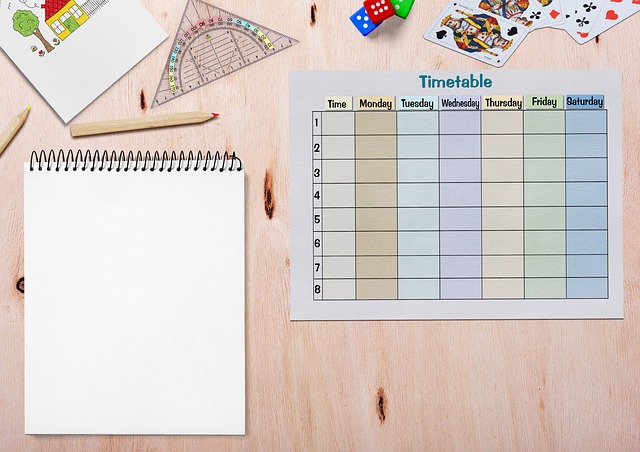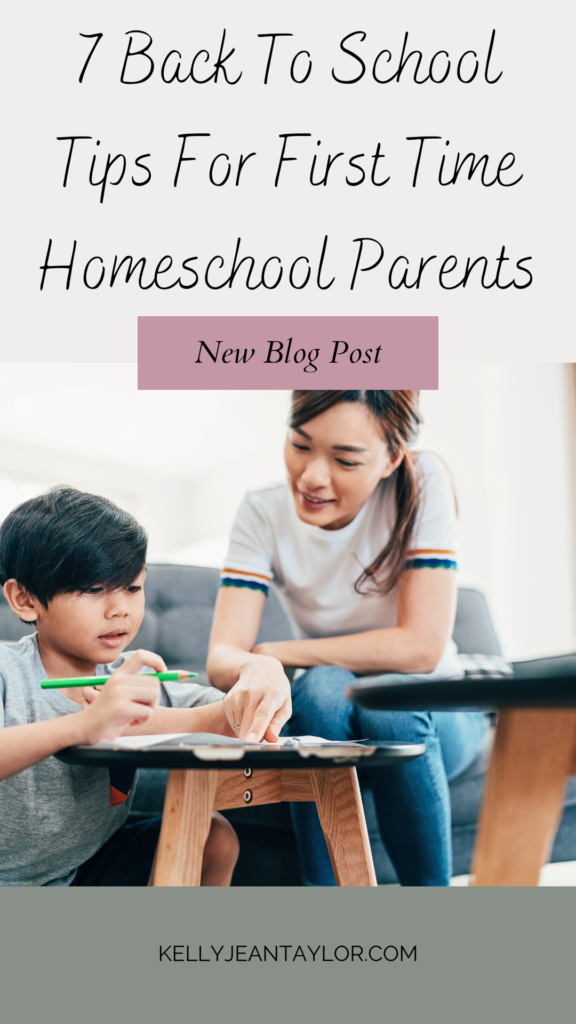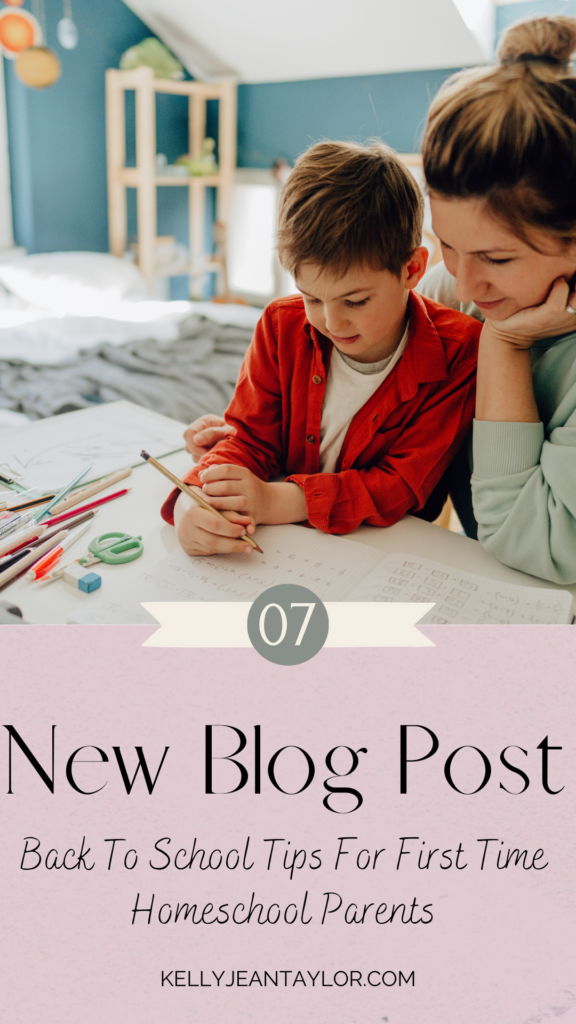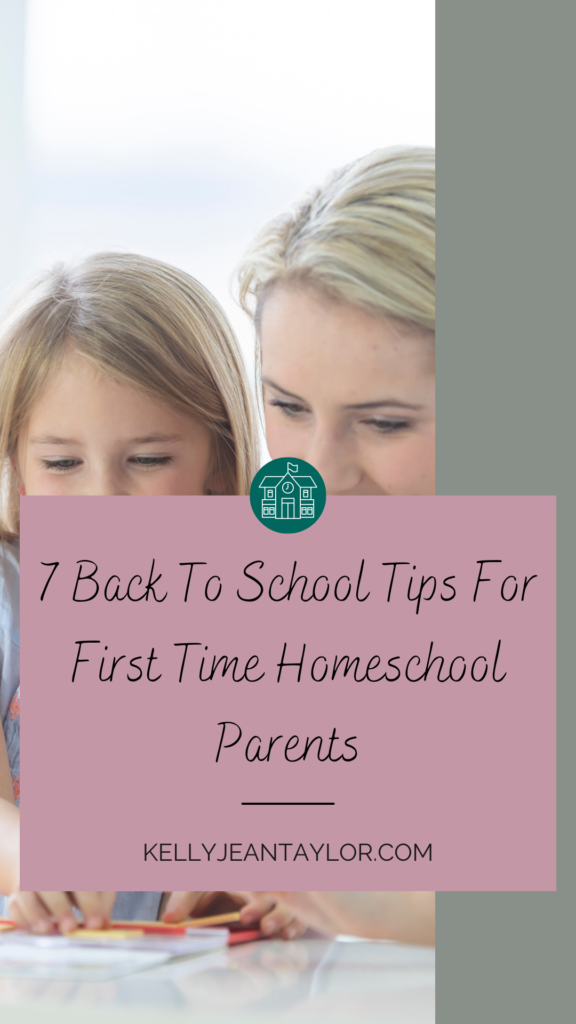
7 Back To School Tips For First Time Homeschool Parents
That first decision to bring your children home and teach them is not an easy one to make. Im sure you debated about it for days, weeks, or even months whether to homeschool would be best. Then as you work through school planning, curriculum choice, supplies, field trips, and more, you start wondering if this really was a good idea.
The best thing to do is to take it step-by-step. You’ll need to think of where you’ll be conducting school during the day, where their school work and supplies will be stored, what their school day will look like, and more.
Room Setup and Organization
Deciding where your children will have their school classes at home can be a difficult thing to figure out. Will you put them in the living room where everyone has a comfy spot but a small table space? Or will you get tv tables for them to use? Will you use the dining room table for school as well as eat/communication center? Will you use the kitchen counter? Or will you clear a room/space specifically for their school needs? And how will you organize their supplies and books while not in use?
Room Layouts
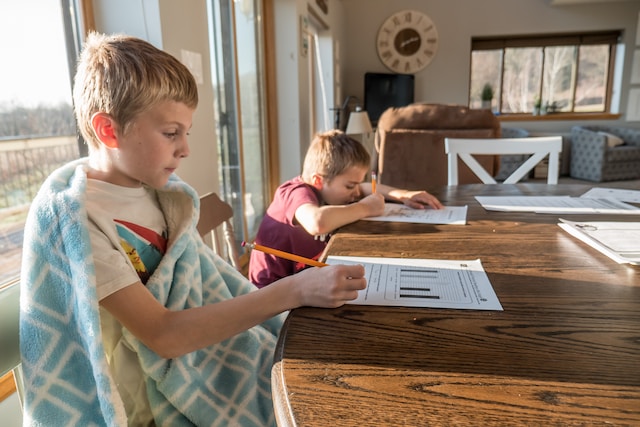
One of the great things about homeschooling is that you are not required to stay in one spot unless you really want to. If it’s nice and you want to do a few lessons outside, you can do that. If you want to take your class to the library, you can do that too. Your school area doesn’t have to be stationary.
I’ve been homeschooling my children for the last seven years and I can tell you that our setup has changed a few times throughout the year. When we first started, I had school in a small alcove in our home with a separate table, and shelves for all their supplies and books. Now it’s moved to the dining room table where they have plenty of room to layout books, do projects, and more. We were also lucky to have received some very large marker boards from my sister when she moved into her current home. Some of the walls were marker board-type paneling, so we took two and created areas where we use them for school (and other things during the off-season).
Think about the space you will need to be using and what you’ll be doing within the space to make sure you have enough to complete your school lessons.
Curriculum
There are some really great homeschool curriculum sets out there that offer all their subject in one, plus some extras. We’ve actually used Timberdoodle.com (not affiliated) for years. We decided this year to start expanding and have incorporated a piece or two from other companies to fill in areas we felt needed something different.
Researching curriculum is long and tedious, but once you find the one or ones you like, you can stick with them. You certainly are not required to get all your curriculum from one place and if you prefer online, that’s available as well. I know many others who piece together their curriculum from many different places because they felt one company had something that would fill the gap in one subject better than others. So do your research and find what will fit you and each of your children best.
Here is a list of some great homeschool curriculum companies you can check out check out:
- Alpha Omega Publications (LifePac, Horizons, and more)
- BJU Press
- Abeka
- Brideway
- Teaching Textbooks
- Sonlight
- Timberdoodle
Schedules and Plans
With providing a homeschool for your child(ren), it can be difficult to get schedules to work together. Once you’ve planned out your week and what you’ll be doing, along with your kids, it will make the process much better.
Here are some ways you can schedule and plan your homeschool to make it run smoother throughout the year. Of course, you’ll have to try them and see what works best for you and your family.
Schedules and Routines
Schedules, although my daughter hates them for some unknown reason, are a great way to keep everyone on track and know what’s coming next. It gives structure to those that need a bit more guidance and goals for those that are goal-oriented. Routines allow you and your child(ren) to establish a rhythm for the day.
We have a morning routine, a school routine, and after school routine so that not only my children, but myself included, know what needs to be done and what to expect during any given day. Of course, weekends and holidays are relaxed.
You can create schedules or routines with time slots, as a checklist, or a checklist with an end time. We use the end-time method for the morning, my children know we start school at 8 am, and they have from 6 am till then to eat, get dressed, brush their teeth, review their lessons, and do their chores. If they finish with time to spare, they have some free time to read or play a learning game before school starts. We then use scheduled times for classes and breaks and end times for after-school duties. This method has worked for us for years.
Plans
Getting started with planning your homeschool may seem overwhelming and it can be. The best thing to do is take it step-by-step and do tasks one at a time. This will give you the framework you need and the ability to customize your school year the way you want, adding in fun extras where you wish.
Step 1: Vision and Goals
When you are starting your homeschool, it’s imperative that you know what vision you have for it as well as goals for you, your children, and the curriculum you choose for the year. This will give you something to work toward as the year progresses.
Make it fun with rewards for daily or weekly goal accomplishments and those you have for the curriculum… if it doesn’t reach your goals, then you know you may need to research a different one for a specific subject it didn’t work with. You are at least giving it a shot and you’re also learning how your children learn so you can adjust to fit their learning style. Trust me, once you know how your children learn best, it will make planning and teaching a lot easier.
Step 2: Room Layout and Organization
One thing you want to consider as mentioned above is where you will be teaching your children. What type of setup will you have and how will you organize their books and supplies? Will you use a space you already have such as the dining room or will you create a new space in the home for their school area? Are you going to be flexible so you can enjoy days outside when it’s nice?
As for supplies and books, will you use bins, buckets, or shelves? Will you do something different and put in lockers to have a public school feel (also a great place to store books) or will you organize all their things in one area for them to find as they need? These are all things you’ll need to think about when deciding where, when, and how you’ll set up and organize your school room.
Step 3: Your “Office”
When you are teaching your children, you’ll find that you will actually have a bit of time to grade while they work or plan the next week/month. Of course, some children will need more help than others, but that doesn’t mean you should be prepared for any downtime you may have in between or during lunch or recess to review classes, grade a subject or two, or plan the next day’s lessons.
Now you need to decide if you’ll be setting up a new desk area for school or if will you be using your current office for your school needs as well. This is completely up to you and what works best for your and your family.
I personally have a smaller desk out where my children learn so that I am there to teach whenever they need me. All of my teaching materials are on that desk and away from my office to keep them separate. That’s not to say that I don’t do planning in my office, I do. Nothing comes in that isn’t what I’m currently working on and it goes back out when I’ve stopped for the day. I’m able to grade when I have a few moments, I’m right there if one of my children is struggling so we can go over what they are working on and I can plan/review the next day’s work in between teachings.
How will you set up your school and office areas?
Step 4: Curriculum Research and Choice
There are a ton of curriculum choices out there these days and choosing one can be a difficult decision. Parents often spend months researching, debating, and deciding on what curriculum to use. Whether they want to go with an all-in-one kit or piece them together for different subjects and interests.
We’ve been using Timberdoodle’s all-in-one curriculum kits for years. This year we decided to change it up as our daughter tends to have difficulty focusing. We are working with her to find what’s right for her learning. Even though we’ve gotten a kit most years, we added things we thought our children would enjoy. We’ve added Theatre for our daughter who LOVES acting singing and dancing; Game design for our son, who, like his mom loves gaming.
The problem we had is that when lessons were created, it became a “chore” for them and they lost interest. I feel they also have a preconceived notion of what the subject entailed. Once they started learning it wasn’t everything they thought, it became a disappointment for them. So, a word of caution there to add subjects if you feel your children would continue to enjoy the subject if it were broken down into smaller pieces of learning areas.
Step 5: Schedule Layout
Your schedule is another area you will need to set up according to how you and your family work best. There are different types of scheduling options such as:
- Looping: Rotating through a list of subjects in order to cover selected material. This allows you to have flexibility when things come up and a class is missed, you’ll start where you left off instead of trying to make it up.
- Block: Blocking times for specific subjects. Longer blocks for a tougher subject, shorter blocks for easier subjects.
- Year-round Schedule: You have school year-round with a smaller week to two-week breaks when needed rather than a summer vacation.
- Four Day Schedule: Have school four days a week and always have a three day weekend.
- School Schedule: Follow the local school district in terms of days off, holidays, etc.
In our homeschool, our family actually follows my sister’s kid’s school schedule as we tend to do a lot together (we are twins), so when they have off, we’ll have off in case we want to plan something.
Your plan can be as loose and minimal or as detailed as you want. Try one way then the other. You may find that one way works better than the other as you’re planning. You do you and what fits your family.
Step 6: Lesson Familiarity and Planning
This is where you want to get familiar with your children’s homeschool curriculum by subject. Go through them, and read the parent letters in each book. Check out the suggested schedules that most have in the front or back of the book and plan out the lessons to the best of your ability. You want to make sure you know what you’re doing as you teach each lesson.
Step 7: Add the Fun
Have fun, you never know what you’ll learn as you teach each lesson. I know I’ve learned things I didn’t know before teaching my children and their funny antics make for great memories.
Add in things your children would enjoy to make the days relaxing and fun. Use national days to add snacks, field trips, activities, and more. School may be all learning, but that doesn’t mean you can’t add fun every now and then. Give them something to get excited about, something to smile about and laugh about.
Bonus: Some of Our Homeschool Memories
- My son told me his head hurt, after asking if he hit it on anything or if it just hurt, I gave him some water and said we would keep an eye on it for a bit. His response was, “It’s my spider sense!” I nearly fell out of my chair laughing.
- My daughter was reading a story about a three-headed purple alien that was roaming around a closed amusement park looking for funnel cake of all things. So I started saying “Me want funnel cake” in a funny alien voice that had both kids cracking up!
- My daughter had to unscramble ice cream flavors and had _______ chip as one. Her response “Potato Chip!” So I started talking with a southern accent (why southern, I don’t know) and asked for potato chip ice cream, insisting more on it because I wanted salt on it. They still ask for the “Southern Potato Chip lady” every now and then.
- My son had to think of things that melt for one of his subjects. On his sheet, he wrote: gold, ice, and The Wicked Witch of the West!
- You get answers like these:
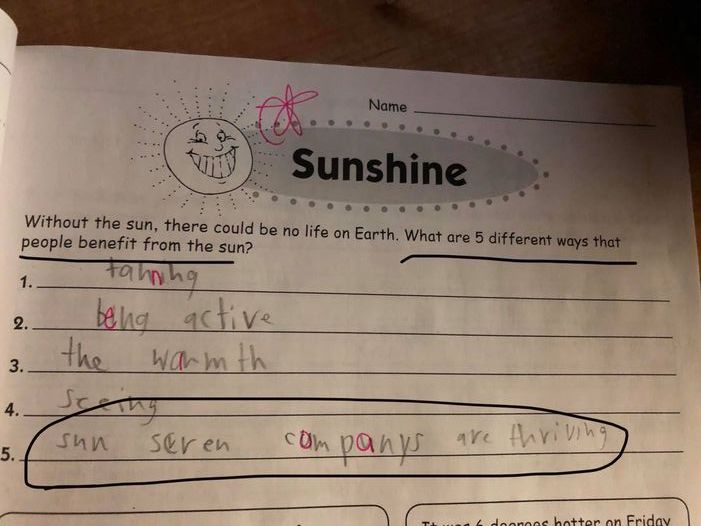
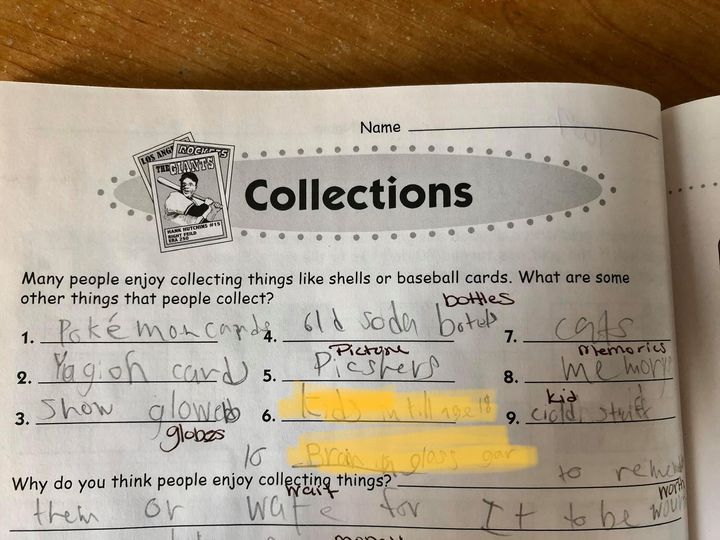
Final Thoughts
Teaching homeschool can be such a blessing, not only do you learn things about your kids you didn’t know; you learn things you didn’t know before. I will never forget reading about giraffes with my son. How their bodies are the way they are so their heads wouldn’t explode when they bend to drink water. Or when my daughter had to unscramble ice cream flavors and she said potato chip! It’s a running joke to this day!
We couldn’t be happier to bring our children home and teach them. We are not only learning about them but things we wouldn’t or hadn’t learned ourselves. It’s a great experience for both your children and yourself.


